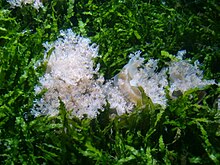This is an old revision of this page, as edited by Avoided (talk | contribs) at 01:08, 6 January 2011 (Reverted edits by 68.5.12.74 (talk) to last revision by ClueBot NG (HG)). The present address (URL) is a permanent link to this revision, which may differ significantly from the current revision.
Revision as of 01:08, 6 January 2011 by Avoided (talk | contribs) (Reverted edits by 68.5.12.74 (talk) to last revision by ClueBot NG (HG))(diff) ← Previous revision | Latest revision (diff) | Newer revision → (diff)
| Cassiopea | |
|---|---|

| |
| Cassiopea spp. | |
| Conservation status | |
 Least Concern (IUCN 3.1) | |
| Scientific classification | |
| Kingdom: | Animalia |
| Phylum: | Cnidaria |
| Class: | Scyphozoa |
| Order: | Rhizostomae |
| Family: | Cassiopeidae |
| Genus: | Cassiopea |
| Species | |
- You may be looking for Cassiopeia
- For the constellation with a similar name, see Cassiopeia (constellation). For the fictional character in Encantadia, see Cassiopea.
Cassiopea is a genus of scyphozoan jellyfish very commonly found in shallow mangrove swamps, mudflats, and turtle grass flats in Florida and various other similar environments around the world, where it lives usually upside-down on the bottom. Where found, there may be numerous individuals with varying shades of white, blue, green and brown. They have a mild sting since they are primarily photosynthetic, but sensitive individuals may have a stronger reaction. The stinging cells are excreted in a mucus; swimming over these jellies (especially using swim fins) may cause transparent, essentially invisible, sheets of this mucus to be lifted up into the water column, where they are then encountered by unsuspecting swimmers. The stings, appearing in the form of a red rash-like skin irritation, are notorious for being extraordinarily itchy.
The Cassiopea jellyfish (one common species is Cassiopea andromeda) belongs to the Order Rhizostomeae and mostly lives in sandy areas and seagrass beds. The Cassiopea jellyfish is also called "Upside Down Jellyfish", because it lies on its back, so that the bell touches the ground. In this position it resembles a sea anemone. Sometimes this jellyfish is picked up by a crab (Dorippe frascone) and carried on its back. The crab uses the jellyfish to defend itself against possible predators.

External links
- Photo of a Crab carrying an Upside Down Jellyfish (Cassiopea andromeda)
- Bernice Pauahi Bishop Museum entry on Cassiopea andromeda
- A Symbiotic Lifestyle: C. xamachana and Zooxanthellae
This cnidarian-related article is a stub. You can help Misplaced Pages by expanding it. |